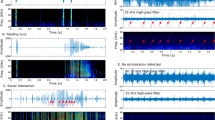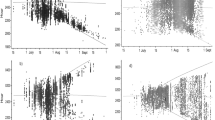Summary
The echolocation and hunting behavior of two very small bats, Craseonycteris thonglongyai (Hill) and Myotis siligorensis (Horsfield), from Thailand, were investigated using multiflash photographs, video, and high-speed tape recordings with a microphone array that allowed determination of distance and direction to the bats. C. thonglongyai is the world's smallest mammal and M. siligorensis is only slightly larger. Both bats hunted insects in open areas. The search signals of C. thonglongyai were 3.5 ms long multiharmonic constant frequency (CF) signals with a prominent second harmonic at 73 kHz repeated at around 22 Hz. The band width (BW) of the short terminal frequency modulated (FM) sweep increased during the very short approach phase. In the final buzz the CF component disappeared, the duration decreased to 0.2 ms, and the repetition rate increased to 215 Hz (Figs. 2, 3, 4). There was no drop in frequency in the buzz. The video recordings of C. thonglongyai indicated that it seizes insects directly with the mouth (Fig. 1). M. siligorensis produced 5.4 ms long CF search signals at 66 kHz. The repetition rate was around 13 Hz. In the approach phase an initial broad band FM sweep was added. The buzz consisted of two phases, buzz I and buzz II. Buzz 11 was characterized by short cry durations (around 0.3 ms), a constant high repetition rate (185 Hz), a distinct drop in frequency, and a prominent second harmonic (Figs. 5, 6, 7). The drop in frequency, apparently typical of vespertilionid bats, has been explained by physiological limitations in sound production. However, C. thonglongyai produced very short signals at very high repetition rates without any frequency drop. The drop may be of adaptive value since it enables M. siligorensis to produce very short signals with high sweep rates. The drop moves the pronounced second harmonic into the frequency range of most interest to the bat (Fig. 7D). The sweep rate in this frequency range may now increase to twice the maximum rate that the vocal cords can produce directly. C. thonglongyai and M. siligorensis belong to different superfamilies, Emballonuroidea and Vespertilionoidea, respectively. In spite of their phylogenetic distance they produce strikingly similar search signals of narrow BW around 70 kHz with high source levels (100–115 dB peSPL peak equivalent sound pressure level). We argue that the signal resemblance is due to the similarity in size and hunting behavior of the two bats both hunting insects in open areas. High frequencies are heavily attenuated in air, but because of their small size the bats are restricted to hunting small insects which only reflect echoes at high frequencies. Thus, the emitted frequency is probably the lowest possible given the prey size. Hence, the two bats can only maximize the range of their sonar by decreasing the BW and emitting high intensities.
Similar content being viewed by others
References
Ahlén I (1981) Identification of Scandinavian bats by their sounds (Report 6). Swedish University of Agricultural Sciences, Department of Wildlife Ecology, Uppsala
Andersen BB, Miller LA (1977) A portable ultrasonic detection system for recording bat cries in the field. J Mammal 58:226–229
Aldridge HDJN, Rautenbach IL (1987) Morphology, echolocation and resource partitioning in insectivorous bats. J Anim Ecol 56:763–778
Baagøe H (1987) The Scandinavian bat fauna: adaptive wing morphology and free flight in the field. In: Fenton MB, Racey PA, Rayner JMV (eds) Recent advances in the study of bats. Cambridge University Press, Cambridge, pp 57–74
Barclay RMR (1983) Echolocation calls of emballonurid bats from Panama. J Comp Physiol 151: 515–520
Barclay RMR, Brigham RM (1991) Prey detection, dietary niche breadth, and body size in bats: Why are aerial insectivorous bats so small? Am Nat 137:693–703
Brüel and Kjær (1982) Condenser microphones and microphone preamplifiers for acoustic measurements, data handbook. Brüel & Kjær, Nærum, Danmark
Duangkhae S (1990) Ecology and behavior of Kitti's hog-nosed bat (Craseonycteris thonglongyai) in western Thailand. Nat Hist Bull Siam Soc 38:135–161
Fenton MB (1990) The foraging behavior and ecology of animal-eating bats. Can J Zool 68:411–422
Fenton MB, Bell GP (1979) Echolocation and feeding behaviour in four species of Myotis (Chiroptera). Can J Zool 57:1271–1277
Fenton MB, Bell GP (1981) Recognition of species of insectivorous bats by their echolocation calls. J Mammal 62:233–243
Fullard JH, Koehler C, Surlykke A, McKenzie NL (1991) Echolocation ecology and flight morphology of insectivorous bats (Chiroptera) in South-western Australia. Aust J Zool 39:427–438
Griffin DR (1958) Listening in the dark. Yale University Press, New York
Griffin DR (1971) The importance of atmospheric attenuation for the echolocation of bats (Chiroptera). Anim Behav 19:55–61
Griffin DR, Webster FA, Michael CR (1960) The echolocation of flying insects by bats. Anim Behav 8:141–154
Habersetzer J (1981) Adaptive echolocation sounds in the bat Rhinopoma hardwickei. A field study. J Comp Physiol 144:559–566
Hill JE (1974) A new family, genus and species of bat (Mammalia: Chiroptera) from Thailand. Bull British Mus Nat Hist Zool Ser 27:301–336
Hill JE, Smith SE (1981) Craseonycteris thonglongyai. Mamm Species 160:1–4
Kalko EKV, Schnitzler H-U (1989) The echolocation and hunting behavior of Daubenton's bat, Myotis daubentoni. Behav Ecol Sociobiol 24:225–238
Kick SA (1982) Target detection by the echolocating bat, Eptesicus fuscus. J Comp Physiol 145:431–435
Lawrence BD, Simmons JA (1982) Measurements of atmospheric attenuation at ultrasonic frequencies and the significance for echolocation by bats. J Acoust Soc Am 71:585–590
Lekagul B, McNeely JA (1977) Mammals of Thailand. Association for the Conservation of Wildlife, Bangkok
Møhl B (1988) Target detection by echolocating bats. In: Nachtigall PE, Moore PWB (eds) Animal sonar. Processes and performance. Plenum Press, New York London, pp 435–450
Møhl B, Surlykke A, Miller LA (1990) High intensity narwhal clicks. In: Thomas JA, Kastelein RA (eds) Sensory abilities of cetaceans. Plenum Press, New York London, pp 295–303
Neuweiler G (1984) Foraging, echolocation and audition in bats. Naturwissenschaften 71:446–455
Neuweiler G (1990) Auditory adaptations for prey capture in echolocating bats. Physiol Rev 70:615–641
Pettigrew JD (1988) Microbat vision and echolocation in an evolutionary context. In: Nachtigall PE, Moore PWB (eds) Animal sonar. Processes and performance. Plenum Press, New York London, pp 645–650
Pye D (1980) Adaptiveness of echolocation signals in bats. Flexibility in behaviour and in evolution. Trends Neurosci 3:232–235
Pye D (1983) Echolocation and countermeasures. In: Lewis B (ed) Bioacoustics. A comparative approach. Academic Press, London, pp 407–429
Schnitzler H-U, Henson WO Jr (1980) Performance of airborne animal sonar systems: I. Microchiroptera. In: Busnel RG, Fish JF (eds) Animal Sonar Systems. Plenum Press, New York, pp 109–181
Schnitzler H-U, Kalko EKV, Miller LA, Surlykke A (1987) The echolocation and hunting behavior of the bat, Pipistrellus kuhli. J Comp Physiol A 161:267–274
Schumm A, Krull D, Neuweiler G (1991) Echolocation in the notch-eared bat, Myotis emarginatus. Behav Ecol Sociobiol 28:255–261
Simmons JA, Stein RA (1980) Acoustic imaging in bat sonar: Echolocation signals and the evolution of echolocation. J Comp physiol 135:61–84
Simmons JA, Fenton MB, O'Farrell MJ (1979) Echolocation and pursuit of prey by bats. Science 203:16–21
Stapells DR, Picton TW, Smith AD (1982) Normal hearing thresholds for clicks. J Acoust See Am 72:74–79
Surlykke A (1988) Interaction between echolocating bats and their prey. In: Nachtigall PE, Moore PWB (eds) Animal sonar. Processes and performance. Plenum Press, New York London, pp 551–566
Surlykke A (1992) Target ranging and the role of time-frequency structure of synthetic echoes in big brown bats, Eptesicus fuscus. J Comp Physiol A 170:83–92
Suthers RA, Thomas SP, Suthers BJ (1972) Respiration, wing-beat and ultrasonic pulse emission in an echo-locating bat. J Exp Biol 56:37–48
Troest N, Møhl B (1986) The detection of phantom targets in noise by serotine bats; negative evidence for the coherent receiver. J Comp Physiol A 159:559–567
Webster FA, Griffin DR (1962) The role of the flight membranes in insect capture by bats. Anim Behav 10: 332–340
Wiersma H (1988) The short-time-duration narrow-bandwidth character of odontocere echolocation signals. In: Nachtigall PE, Moore PWB (eds) Animal sonar systems. Plenum Press, New York London, pp 129–145
Author information
Authors and Affiliations
Additional information
Correspondence to: A. Surlykke
Rights and permissions
About this article
Cite this article
Surlykke, A., Miller, L.A., Møhl, B. et al. Echolocation in two very small bats from Thailand Craseonycteris thonglongyai and Myotis siligorensis . Behav Ecol Sociobiol 33, 1–12 (1993). https://doi.org/10.1007/BF00164341
Received:
Accepted:
Issue Date:
DOI: https://doi.org/10.1007/BF00164341




